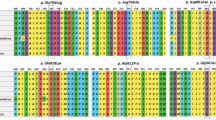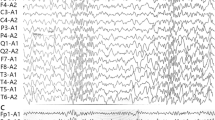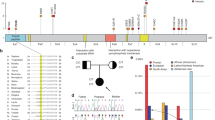Abstract
Background
ATP1A3 is a gene that encodes the ATPase Na + /K + transporting subunit alpha-3 isoenzyme that is widely expressed in GABAergic neurons. It maintains metabolic balance and neurotransmitter movement. These pathways are essential for the proper functioning of the nervous system. A mutation in the ATP1A3 gene demonstrates remarkable genotype–phenotype heterogeneity.
Objectives
To provide insight into patients with ATP1A3 mutation.
Material and methods
These cases were identified using next generation sequencing. The patients' clinical and genetic data were retrieved. Detailed revision of the literature was conducted to illustrate and compare findings. The clinical, genetical, neuroimaging, and electrophysiological data of all pediatric patients were extracted.
Results
The study included 14 females and 12 males in addition to two novel females cases. Their mean current age is 6.3 ± 4.24 years. There were 11.54% preterm pregnancies with 5 cases reporting pregnancy complications. Mean age of seizure onset was 1.07 ± 1.06 years. Seizure semiology included generalized tonic–clonic, staring spells, tonic–clonic, and others. Levetiracetam was the most frequently used Anti-seizure medication. The three most frequently reported classical symptoms included alternating hemiplegia of childhood (50%), cerebellar ataxia (50%), and optic atrophy (23.08%). Non-classical symptoms included dystonia (73.08%), paroxysmal dyskinesias (34.62%), and encephalopathy (26.92%). Developmental delay was reported among 84.62% in cognitive, 92.31% in sensorimotor, 80.77% in speech, and 76.92% in socioemotional. EEG and MRI were non-specific.
Conclusion
Our study demonstrated high heterogeneity among patients with pathogenic variants in the ATP1A3 gene. Such variation is multifactorial and can be a predisposition of wide genetic and clinical variables. Many patients shared few similarities in their genetic map including repeatedly reported de novo, heterozygous, mutations in the gene. Clinically, higher females prevalence of atypical presentation was noted. These findings are validated with prior evidence and the comprehensive analysis in this study.




Similar content being viewed by others
Data availability
The datasets used and/or analyzed during the current study are available from the firts author on reasonable request.
References
Allocco AA, Jin SC, Duy PQ, Furey CG, Zeng X, Dong W et al (2019) Recessive Inheritance of Congenital Hydrocephalus With Other Structural Brain Abnormalities Caused by Compound Heterozygous Mutations in ATP1A3. Front Cell Neurosci 26(13):425–425
Alyamani SA, Aldhalaan HM, Almuhaizea MA, Abukhalid MF (2023) Expanding the Allelic spectrum in ATP1A3-related disorders with 3 novel mutations and clinic features. Neurosciences (riyadh) 28(3):195–198
Arystarkhova E, Haq IU, Luebbert T, Mochel F, Saunders-Pullman R, Bressman SB et al (2019) Factors in the disease severity of ATP1A3 mutations: Impairment, misfolding, and allele competition. Neurobiol Dis 1:132
Ben YT, Benrhouma H, Klaa H, Rouissi A, Chaabouni M, Kraoua I et al (2018) Early Life Epilepsy and Episodic Apnea Revealing an ATP1A3 Mutation: Report of a Pediatric Case and Literature Review. Neuropediatrics 49(5):339–341
Berberich AJ, Ho R, Hegele RA (2018) Whole genome sequencing in the clinic: empowerment or too much information? CMAJ : Canadian Med Assoc J 190(5):E124
Bøttger P, Tracz Z, Heuck A, Nissen P, Romero-Ramos M, Lykke-Hartmann K (2011) Distribution of Na/K-ATPase alpha 3 isoform, a sodium-potassium P-type pump associated with rapid-onset of dystonia parkinsonism (RDP) in the adult mouse brain. J Comp Neurol 519(2):376–404
Brashear A, Sweadner KJ, Cook JF, Swoboda KJ, Ozelius L. (1993) ATP1A3-Related Neurologic Disorders.
Calame D, Shinawi M, Cohen J, Person R, Telegrafi A, Lotze T et al (1946) Atypical phenotypes caused by the ATP1A3 variant p.P775L. Neurology 94(15):2020
Chaumette B, Ferrafiat V, Ambalavanan A, Goldenberg A, Dionne-Laporte A, Spiegelman D et al (2018) Missense variants in ATP1A3 and FXYD gene family are associated with childhood-onset schizophrenia. Mol Psychiatry 25(4):821–830
Chi LY, Zhao XH, Liu XW, Jiang WJ, Chi ZF, Wang SJ (2012) Alternating hemiplegia of childhood in chinese following long-term treatment with flunarizine or topiramate. Int J Neurosci 122(9):506–510
Cordani R, Stagnaro M, Pisciotta L, Tiziano FD, Calevo MG, Nobili L et al (2021) Alternating Hemiplegia of Childhood: Genotype-Phenotype Correlations in a Cohort of 39 Italian Patients. Front Neurol 8(12):658451
Dard R, Mignot C, Durr A, Lesca G, Sanlaville D, Roze E et al (2015) Relapsing encephalopathy with cerebellar ataxia related to an ATP1A3 mutation. Dev Med Child Neurol 57(12):1183–1186
Dobyns WB, Ozelius LJ, Kramer PL, Brashear A, Farlow MR, Perry TR et al (1993) Rapid-onset dystonia-parkinsonism. Neurology 43(12):2596–2596
Gagnier JJ, Kienle G, Altman DG, Moher D, Sox H, Riley D et al (2013) The CARE guidelines: Consensus-based clinical case reporting guideline development. J Med Case Rep 7(1):1–6
Galaz-Montoya CI, Alcaraz-Estrada S, García-Montaño LA, Zenteno JC, Piña-Aguilar RE (2019) A recurrent de novo mutation in ATP1A3 gene in a Mexican patient with alternating hemiplegia of childhood detected by massively parallel sequencing. Bol Med Hosp Infant Mex 76(1):49–53
Green BN, Johnson CD, Adams A (2006) Writing narrative literature reviews for peer-reviewed journals: secrets of the trade. J Chiropr Med 5(3):101
Heinzen EL, Swoboda KJ, Hitomi Y, Gurrieri F, De Vries B, Tiziano FD et al (2012) De novo mutations in ATP1A3 cause alternating hemiplegia of childhood. Nat Genet 44(9):1030–1034
Heinzen EL, Arzimanoglou A, Brashear A, Clapcote SJ, Gurrieri F, Goldstein DB et al (2014) Distinct neurological disorders with ATP1A3 mutations. Lancet Neurol 13(5):503–514
Holm TH, Lykke-Hartmann K (2016a) Insights into the pathology of the α3 Na+/K+-ATPase ion pump in neurological disorders; lessons from animal models. Front Physiol 7:197078
Holm TH, Lykke-Hartmann K (2016b) Insights into the Pathology of the α3 Na(+)/K(+)-ATPase Ion Pump in Neurological Disorders Lessons from Animal Models. Front Physiol. https://doi.org/10.3389/fphys.2016.00209
Ishihara N, Inagaki H, Miyake M, Kawamura Y, Yoshikawa T, Kurahashi H (2019) A case of early onset life-threatening epilepsy associated with a novel ATP1A3 gene variant. Brain Dev 41(3):285–291
Ishii A, Saito Y, Mitsui J, Ishiura H, Yoshimura J, Arai H et al (2013) Identification of ATP1A3 Mutations by Exome Sequencing as the Cause of Alternating Hemiplegia of Childhood in Japanese Patients. PLoS ONE 8(2):e56120
Liu J, Tong L, Song S, Niu Y, Li J, Wu X et al (2018) Novel and de novo mutations in pediatric refractory epilepsy. Mol Brain 11(1):48
Marzin P, Mignot C, Dorison N, Dufour L, Ville D, Kaminska A et al (2018) Early-onset encephalopathy with paroxysmal movement disorders and epileptic seizures without hemiplegic attacks: About three children with novel ATP1A3 mutations. Brain Dev 40(9):768–774
Moriyama K, Mizuno T, Suzuki T, Inaji M, Maehara T, Fujita A et al (2023) ATP1A3-related early childhood onset developmental and epileptic encephalopathy responding to corpus callosotomy: A case report. Brain Dev 45(1):77–81
Muthaffar OY, Jan MMS, Alyazidi AS, Alotibi TK, Alsulami EA (2023) Insight into Genetic Mutations of SZT2: Is It a Syndrome? Biomedicines 11(9):2402
Neupert D, Abbassi P, Prange L, Flamini R, Mikati MA (2022) Progression of alternating hemiplegia of childhood-related focal epilepsy to electrical status epilepticus in sleep with reversible encephalopathy. Epileptic Disord 24(1):183–190
Nicolaides P, Appleton RE, Fryer A (1996) Cerebellar ataxia, areflexia, pes cavus, optic atrophy, and sensorineural hearing loss (CAPOS): a new syndrome. J Med Genet 33(5):419–421
Paciorkowski AR, McDaniel SS, Jansen LA, Tully H, Tuttle E, Ghoneim DH et al (2015) Novel mutations in ATP1A3 associated with catastrophic early life epilepsy, episodic prolonged apnea, and postnatal microcephaly. Epilepsia 56(3):422–430
Panagiotakaki E, de Grandis E, Stagnaro M, Heinzen EL, Fons C, Sisodiya S et al (2015) Clinical profile of patients with ATP1A3 mutations in Alternating Hemiplegia of Childhood-a study of 155 patients. Orphanet J Rare Dis. https://doi.org/10.1186/s13023-015-0335-5
Pirahanchi Y, Jessu R, Aeddula NR (2023) Physiology. Sodium Potassium Pump, StatPearls, US
Prange L, Pratt M, Herman K, Schiffmann R, Mueller DM, McLean M et al (2020) D-DEMØ, a distinct phenotype caused by ATP1A3 mutations. Neurol Genet 6(5):1
Rosewich H, Thiele H, Ohlenbusch A, Maschke U, Altmüller J, Frommolt P et al (2012) Heterozygous de-novo mutations in ATP1A3 in patients with alternating hemiplegia of childhood: A whole-exome sequencing gene-identification study. Lancet Neurol 11(9):764–773
Sabouraud P, Riquet A, Spitz MA, Deiva K, Nevsimalova S, Mignot C et al (2019) Relapsing encephalopathy with cerebellar ataxia are caused by variants involving p.Arg756 in ATP1A3. Eur J Paediatr Neurol 23(3):448–455
Salles PA, Mata IF, Brünger T, Lal D, Fernandez HH (2021) ATP1A3-Related Disorders: An Ever-Expanding Clinical Spectrum. Front Neurol 1(12):637890
Shattock MJ, Ottolia M, Bers DM, Blaustein MP, Boguslavskyi A, Bossuyt J et al (2015) Na+/Ca2+ exchange and Na+/K+-ATPase in the heart. J Physiol 593(Pt6):1361
Suhail M (2010) Na+, K+-ATPase: Ubiquitous Multifunctional Transmembrane Protein and its Relevance to Various Pathophysiological Conditions. J Clin Med Res 2(1):1
Verret S, John S (1971) Alternating hemiplegia in childhood: a report of eight patients with complicated migraine beginning in infancy. Pediatrics 47(4):675–680
Vetro A, Nielsen HN, Holm R, Hevner RF, Parrini E, Powis Z et al (2021) ATP1A2- and ATP1A3-associated early profound epileptic encephalopathy and polymicrogyria. Brain 144(5):1435–1450
Viollet L, Glusman G, Murphy KJ, Newcomb TM, Reyna SP, Sweney M et al (2015) Alternating Hemiplegia of Childhood: Retrospective Genetic Study and Genotype-Phenotype Correlations in 187 Subjects from the US AHCF Registry. PLoS ONE 10(5):e0137370
Yang G, Zhao Z, Yang Y, Lin L, Song C, Wang X et al (2021) Alternating Hemiplegia of Childhood Caused by ATP1A3 Mutations: A Report of Two Cases. Chin Med Sci J 36(2):150–157
Yano ST, Silver K, Young R, DeBrosse SD, Ebel RS, Swoboda KJ et al (2017) Fever-Induced Paroxysmal Weakness and Encephalopathy, a New Phenotype of ATP1A3 Mutation. Pediatr Neurol 1(73):101–105
Zou S, Lan YL, Gong Y, Chen Z, Xu C (2023) The role of ATP1A3 gene in epilepsy: We need to know more. Front Cell Neurosci 17:1143956
Zúñiga-Ramírez C, Kramis-Hollands M, Mercado-Pimentel R, González-Usigli HA, Sáenz-Farret M, Soto-Escageda A et al (2019) Generalized Dystonia and Paroxysmal Dystonic Attacks due to a Novel ATP1A3 Variant. Tremor Other Hyperkinet Mov (n y) 9(1):5
Acknowledgement
The authors extend their appreciation to the King Salman center For Disability Research for funding this work through Research Group no KSRG-2023-024.
Author information
Authors and Affiliations
Corresponding author
Ethics declarations
Conflict of interest
The author declares no conflict of interest.
Ethical approval
Not applicable.
Informed consent
Not applicable.
Additional information
Publisher's Note
Springer Nature remains neutral with regard to jurisdictional claims in published maps and institutional affiliations.
Rights and permissions
Springer Nature or its licensor (e.g. a society or other partner) holds exclusive rights to this article under a publishing agreement with the author(s) or other rightsholder(s); author self-archiving of the accepted manuscript version of this article is solely governed by the terms of such publishing agreement and applicable law.
About this article
Cite this article
Muthaffar, O.Y., Alqarni, A., Shafei, J.A. et al. Childhood-related neural genotype–phenotype in ATP1A3 mutations: comprehensive analysis. Genes Genom 46, 475–487 (2024). https://doi.org/10.1007/s13258-023-01481-8
Received:
Accepted:
Published:
Issue Date:
DOI: https://doi.org/10.1007/s13258-023-01481-8




